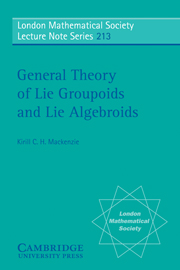Appendix
Published online by Cambridge University Press: 05 April 2013
Summary
This Appendix describes recent and ongoing work on three topics which are closely related to the main text and which, in an ideal world, the author would have covered in full. Some important recent developments are not covered here.
Foliations
The most important single topic which has not been covered is that of the relationship between groupoid theory and foliation theory. An involutive distribution Δ on a manifold M is a Lie subalgebroid of TM = A∏(M). When Δ = Tf M is the vertical bundle of a surjective submersion f: M → N, the Lie subgroupoid R(f) ⊆ M × M of 1.1.8 has Lie algebroid Tf M, but in general an involutive distribution is not the Lie algebroid of a Lie subgroupoid of M × M or ∏(M).
The usual holonomy groups of a foliation ℱ are the vertex groups of the holonomy groupoid of the foliation, introduced in the 1950s and one of the key examples considered by Pradines [1966]. (For historical background, see [Haefliger, 1980].) This groupoid is best understood by first considering the monodromy groupoid of ℱ. Algebraically, the monodromy groupoid ℳ(ℱ) is the disjoint union of the fundamental groupoids of the leaves of ℱ and the holonomy groupoid ℋ(ℱ) is the quotient of ℳ(ℱ) over the totally intransitive subgroupoid which consists of the elements represented by loops with trivial holonomy.
The monodromy groupoid has a natural smooth structure which is not necessarily Hausdorff but in all other respects satisfies the conditions of a Lie groupoid, and is such that the fundamental Lie groupoid of each leaf is a Lie subgroupoid.
- Type
- Chapter
- Information
- General Theory of Lie Groupoids and Lie Algebroids , pp. 473 - 478Publisher: Cambridge University PressPrint publication year: 2005

